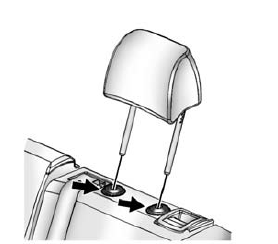Chevrolet Spark Owners Manual: Head Restraint Removal and Reinstallation
The rear outboard head restraints can be removed if they interfere with the proper installation of the child restraint.
To remove the head restraint:
- Partially fold the seatback forward. See Rear Seats on page 3-8 for additional information.

- Press both buttons on the head restraint posts at the same time, and pull up on the head restraint.
- Store the head restraint in the cargo area of the vehicle inside the cargo net.
- When the child restraint is removed, reinstall the head restraint before the seating position is used.
Warning
With head restraints that are not installed and adjusted properly, there is a greater chance that occupants will suffer a neck/ spinal injury in a crash. Do not drive until the head restraints for all occupants are installed and adjusted properly.
To reinstall the head restraint:

- Insert the head restraint posts into the holes in the top of the seatback. The notches on the posts must face the driver side of the vehicle.
- Push the head restraint down.
If necessary, press the height adjustment release button to further lower the head restraint.
See Head Restraints on page 3-2.
- Try to move the head restraint to make sure that it is locked in place.
 Securing a Child Restraint Designed for the LATCH System
Securing a Child Restraint Designed for the LATCH System
Warning
If a LATCH-type child restraint is not attached to anchors or
with the safety belt, the child restraint will not be able to protect the child
correctly. In a crash, the child could be ser ...
 Replacing LATCH System Parts After a Crash
Replacing LATCH System Parts After a Crash
Warning
A crash can damage the LATCH system in the vehicle. A damaged
LATCH system may not properly secure the child restraint, resulting in serious injury
or even death in a crash. To help make ...
Other materials:
Towing the Vehicle
Caution
Incorrectly towing a disabled vehicle may cause damage. The damage
would not be covered by the vehicle warranty.
Have the vehicle towed on a flatbed car carrier or a wheel lift tow truck.
If a wheel lift tow truck is used, the drive wheels cannot contact the road while
the vehicle is ...
Heated Front Seats
Warning
If you cannot feel temperature change or pain to the skin, the
seat heater may cause burns. To reduce the risk of burns, people with such a condition
should use care when using the seat heater, especially for long periods of time.
Do not place anything on the seat that insulates again ...
Rear Seats
Folding the Seatback
Either side of the seatback can be folded down for more cargo space.
Fold a seatback only when the vehicle is not moving.
Caution
Folding a rear seat with the safety belts still fastened may cause
damage to the seat or the safety belts. Always unbuckle the safety belts and ...
